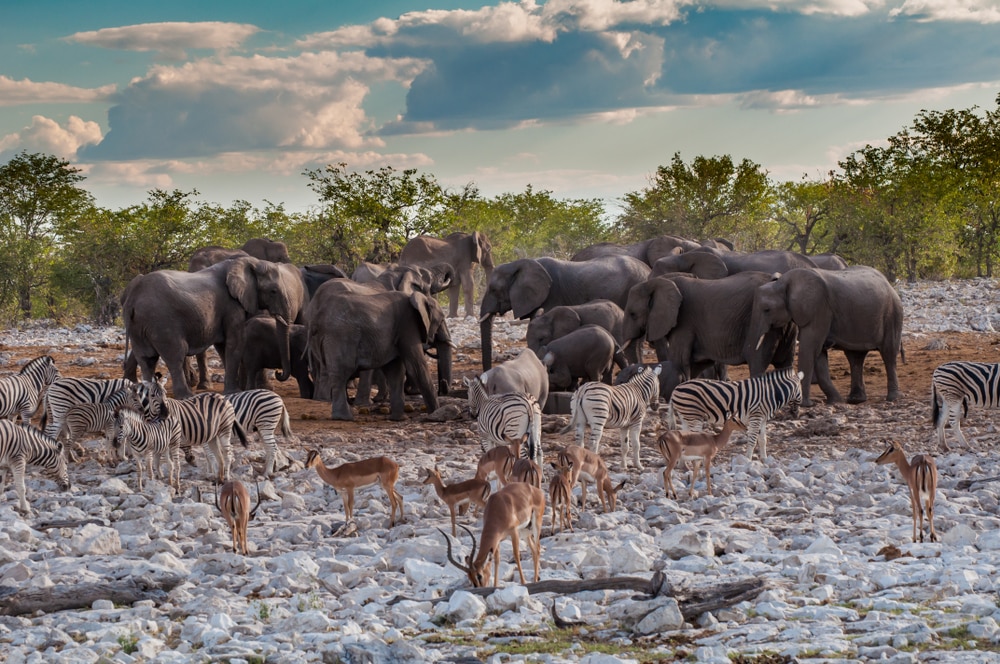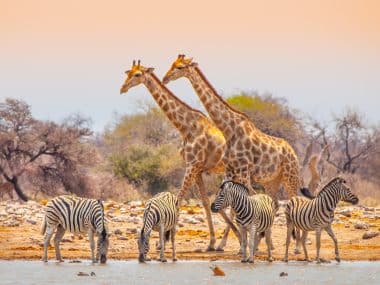
In the north of Namibia, near the border with Angola, lies the Etosha Pan National Park, one of the country’s main attractions. Here, visitors can expect a wealth of species that is second to none and makes encounters with Africa’s wildlife possible at close range.
The Significance of Etosha
The salt pan, also called “Etosha Pan”, was once the bottom of a large inland lake. It covers 4760 km2, about a quarter of the entire park area. The word “Etosha” comes from the Ovambo language and translates as “big white square”. In some years, when the rivers in the east and north are flooded, parts fill with water and thus become a magnet for thousands of flamingos. Visitors can catch a glimpse of the seemingly endless salt desert at the Etosha Lookout, a viewing option on the southern edge of the pan level.
The park’s wildlife

However, the national park does not only consist of the dry white plain, but covers a total of 22,270 km3, which includes the surrounding savannah areas. There are countless large and small waterholes, some of which are of natural origin, some of which have been created by human hands. They are very accessible on roads that run through the park. This offers the opportunity to observe animals all year round, such as the “Big Five” of Africa: elephant, rhinoceros, buffalo, lion and leopard. But the large herds of zebra and antelope migrating through the park are also a feast for the eyes of the viewer. Giraffes roam the wide plains, warthogs and ostriches cross the path, wildebeest and oryx antelopes roam on the horizon. Giant bustards, hornbills, eagles, vultures and numerous other bird species inhabit the edge zones of the Etosha Pan. For birdwatchers, a visit to the Fishers Pan, which is located in the immediate vicinity of Fort Namutoni, is recommended.
Fort Namutoni
In 1903, a fort made of mud bricks was built by the German Schutztruppe. It was destroyed after an attack by the Ovambo and rebuilt in 1905-1907. It has been open to visitors since 1957. Its white walls are recognizable from afar.
Dik-Dik Drive
The dikdik is a small African dwarf antelope. Its subspecies, the Kirkdikdik, lives only in Namibia, on the Waterberg Plateau and in the Etosha National Park in the area of the Dik-Dik Drive, which is located in close proximity to Fort Namutoni. It is worthwhile for visitors to travel this path to observe the small animal with the bambi-like eyes.
Mystical Ghost Forest
Another special feature of the park is the Ghost Tree Forest, called the Ghost or Fairytale Forest. Located about 40 kilometers west of Okaukuejo Camp, it is a naturally formed forest of Moringa trees that have a ghostly appearance.
Spend the night in the park
The park is passable through three gates: Anderson Gate, Von Lindequist Gate, and King Nehale Lya Mpingana Gate. There is the option to spend the night in the park or reserve accommodation outside the park and go on day trips to the park. For self-drivers who want to spend the night in one of the camps within the area, early reservations are recommended.
The most famous state-run camps, Okaukuejo in the west, Halali in the center and Namutoni in the east, offer sleeping accommodations in bungalows and pitches for camping vehicles. All camps have waterholes that are illuminated at night, so that animals can be observed there around the clock. There are restaurants, gas stations, swimming pools and small shops where food and souvenirs are sold.
The Dolomite Camp is located in the western part of the park and offers the opportunity to spend the night in luxurious safari-style tents. Olifantsrus Camp is also located in the western part and is the newest camp in the park. It only offers camping facilities. Onkoshi Camp is built in the northeastern part of the park directly on the salt flats on a wooden platform. Its peculiarity, it is a low-energy camp that offers safaris in the exclusive part of the park.
The Etosha King Nehale Lodge, located in the north of the park, offers 40 very well-equipped bungalows in an exclusive ambience. The special feature: The lodge has a waterhole, which is reserved for guests only.
Travel time Etosha National Park
The best time to see as many animals as possible in the park is from June to September. At this time it is very dry and the animals depend on the artificially created water points in the camps and in the park. The temperatures are very pleasant for visitors, the daytime temperatures are warm but not too hot and the nights are cool and restful.

